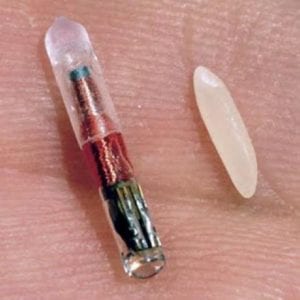Why you should microchip your pet?
If your dog or cat wandered off and got lost, how easy would it be to find them? Every year there are thousands of stray pets and most of them don’t have sufficient distinguishing marks to be identified reliably. Unfortunately, if a cat or dog goes missing, there’s a pretty low chance that you’ll be reunited with them – unless they’re microchipped
What is a microchip?
A microchip is a small electronic device that is inserted under the skin in your pet’s neck (usually just between the shoulder blades). It is about the same size as a grain of rice, and is encased within biocompatible glass or polymer (the same sort of material that is used for some surgical implants). It sits painlessly under the skin for your animal’s lifetime.
How does it work?
The chip is encoded with a unique number. If your pet ever gets lost, as soon as they’re found by someone they’ll be scanned by a vet, dog warden or rescue centre, using a hand-held device that can read the coded number. The number can then be looked up on an online database of owners, and your details located; the person who found them can then ring you up and tell you that they’ve found your long lost best friend!
What happens when the battery runs out?
It never will – the chip doesn’t actually contain a power source, because it’s what is known as a transducer. The radio waves transmitted by the scanner are reflected back by the components in the chip, modulated into a sequence of pulses that encode the number.
Are there any risks to my pet from it – like chemicals or radiation?
Well, it can be a bit uncomfortable to put it in (it is quite a large needle, and a few pets find it a little sore). In addition, there is a very small chance that the chip will move and end up somewhere else in the body – or even be rejected and pushed out through the skin (although that’s really, really rare).
Otherwise, there’s no real danger – the chips are designed to be chemically inert and have no effect on the body, and the radio waves emitted by the scanner are no stronger than your mobile phone or wifi router – well below the threshold for any detectable influence, let alone harm. In fact, there’s no evidence that the chips are harmful at all as long as they’re inserted correctly by a trained professional.
What happens if the chip stops working? Would my pet need surgery to remove the old chip?
It is uncommon for a chip to “die”, but it does occasionally happen. In that case, we’d just insert a new one and notify the database company that we’ve done so, so they can update the number they have on file. We wouldn’t have to remove the old one though – it’s harmless, and we’d do more injury removing it, so we’d leave it in place.
Do I have to microchip my pet?
All dogs MUST be microchipped, by law. However, the same isn’t true of cats, rabbits or other pets – but it’s still a good idea to get it done! You can read more about the law here. The only exception is if you are travelling abroad on the PETS Passport scheme, in which case your dog, cat or ferret must be microchipped before they receive their rabies vaccine.
How can I make sure my pet comes back to me if they get lost?
The most important thing to remember is that you MUST keep the pet database up to date – if you move house, or change phone numbers, and forget to update the records, there’s no way you can be reunited. Remember, the chip doesn’t actually track your pet – it just gives them a permanent ID number. Likewise, when you buy a dog, make sure you notify the database company that you’re the new owner!
